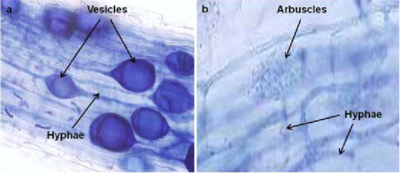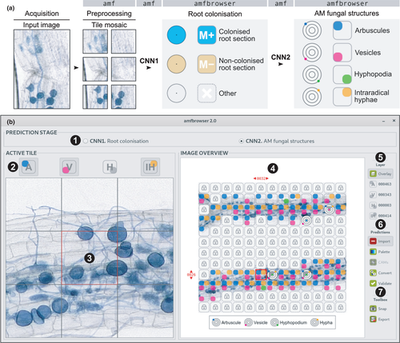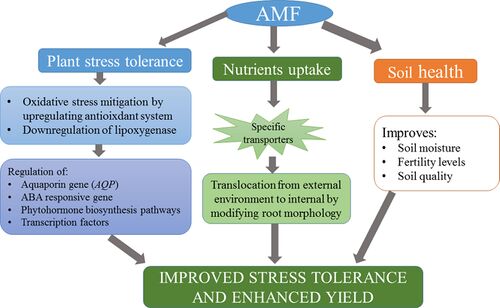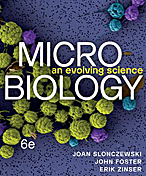The Underground Network: Arbuscular Mycorrhizal Fungi - Sebastian Jones: Difference between revisions
No edit summary |
No edit summary |
||
| Line 47: | Line 47: | ||
<b>Benefits to the Host Plant Beyond Nutrient Exchange</b> <br> | <b>Benefits to the Host Plant Beyond Nutrient Exchange</b> <br> | ||
While the core of the symbiotic relationship is nutrient transfer, particularly phosphorous, there are countless other benefits for the host that go beyond this including: increased drought resistance | While the core of the symbiotic relationship is nutrient transfer, particularly phosphorous, there are countless other benefits for the host that go beyond this including: increased drought resistance and increased soil structure and the prevention of mineral leeching during rainfall <b>REF31</b>. | ||
<u> Increased Drought Resistance </u> | <u> Increased Drought Resistance </u> | ||
Water is crucial to a plant's survival. Different plants may have different levels of natural tolerance for water deprivation, a complete lack of water will eventually kill any plant, just like any other living thing. There has been a significant amount of research that has shown that the mutualistic relationship between the host and AMF can increase the host's drought resistance. <b>REF21</b> There are several reasons that are thought to individual and/or collectively work to increase a plant's drought resistance. First, AMF increase the hydraulic conductivity of the host plant's roots. <b>REF21</b> <b>REF22</b> Hydraulic conductivity refers to how well a plant can move water through its roots, across gradients, to the xylem in the plant stem. Properties of AMF including the hyphal network are thought to increase the host plant's ability to effectively move water. | |||
Second, it is believed that AMF can increase the host plant's ability to regulate its somata. <b>REF21</b> <b>REF22</b> The stomata are typically the underside of a plant's leaves although in some plants they are on the stem. They regulate the gas exchange in plants however when they open, evaporation leads to water loss. Stomata have to open during the day so that photosynthesis can occur but this means that they are open when the plant is most susceptible to water loss from evaporation due to the sunlight. Giving the plant a greater ability to control the stomata would lead to reduced water loss from evaporation. Many droughts, not all, occur in hot, arid climates. This underscores the importance of reducing water loss from evaporation. | |||
The third suggestion to why Arbuscular Mycorrhizal Fungi provide increased drought resistance is that the hyphal network gives the plant's own root system a greater amount of contact with the soil. <b>REF21</b> <b>REF22</b> This is believed to allow plant's to extract greater amounts of water from the soil including from pores that would have otherwise been too small without AMF. <b>REF21</b> <b>REF22</b> | |||
Revision as of 04:40, 8 December 2022
Introduction
Arbuscular Mycorrhizal Fungi (AMF) are a symbiotic fungi that colonize plant roots and form a mutualistic relationship. Over 70% of land plants have formed a symbiotic relationship with AMF.REF20 They are identifiable by their unique structures vesicles, hyphae and arbuscles (Image 1). Three of the most common types of mycorrhizal symbioses are, ectomycorrhizal, endomycorrhizal and ecto-endomycrorizha. AMF's are the second, endomycorrhizal REF10. Arbuscular Mycorrhizal Fungi play many roles in an ecosystem. One of the most important roles of the AMF is the transfer of Phosphorous and Carbon between it and the host plant REF. In addition, they increase the resistance of their host to salinity and heavy metals REF29 REF30, insects REF, droughts REF27, and soil pathogens REF28. They have also been shown to contribute to enhanced soil; Increasing soil structure, particularly in agricultural settings and preventing the loss of important nutrients due to rainfall REF31.
History
The human history of understanding Arbuscular Mycorrhizal Fungi began in 1840 when Robert Hartig when he thought he was describing a root parasite, however, paleobotanical, morphological and phylogenetic data show that more than 400 million years, plants and AMF have coevolved REF11. Then in 1885, Albert Bernard Frank was the first to conceptualize it. Research has continued to this day with constant technological advances allowing new discoveries to be nearly constantly made. A recent important technological advancement was the advent of computer software that automatically quantifies the degree of AMF colonization of a plant root. The discovery was made by Cambridge's Sainsbury Laboratory and it is called AMFinder. It was developed with convolutional neural networks and it is able to accurately identify colonization in several plants commonly used in AMF research REF12.
Genetics
As with the technology used to analyze AMF, there has also been considerable advancements in the understanding of AMF genetics. Using rice (Oryza sativa) as a model organism, researchers have studied the genes necessary for mycorrhizal formation REF16. The genes CASTOR, POLLUX, CCAMK (DMI3), and CYCLOPS were found to be critical for the formation of mycorrhiza in legumes and rice REF16. However, there were two groups types of genes found that are specific only to mycorrhiza formation. The first group is expressed early in development. It includes AM1-3 and AM11. The second group contains genes that are expressed later in development REF16. These genes are: AM10, 11, 14, 15, 18, 20, 24, 25, 26, 29, 31, 34, 39, 42 and PT11. Additionally, phosphate transport is hugely important to in the symbiotic relationship of plants and AMF, two plant phosphate transporters have been identified. Genes PT4 and PT3 in addition to contributing to phosphate transport are also believed to have a role in maintenance and life span of arbuscles REF17. Given that they are expressed in the arbuscle, these genes are thought to have a significant role in symbiosis REF17.
Genetic Material Exchange
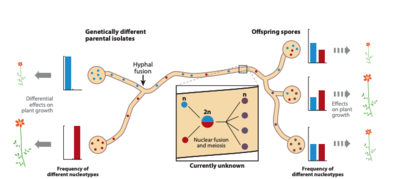
Another aspect of arbuscular mycorrhizal fungal genetics that is being researched but currently, not completely understood is the process of nuclear fusion and then meiosis between two genetically different parental AMF. The hyphal networks of two unrelated AMF can fuse together. This process is called hyphal fusion. Once this occurs, a form of genetic exchange is possible between the two different nuclei. This was proven in a lab setting when two hyphal networks were grown together. The two parental networks joined and after six months, new spore were able to colonize plant roots <br18>. When two parent nuclei join together, it is unknown whether the genetic exchange is caused by nuclear fusion, recombination or meiosis. [1] However the authors state that "This as a priority for research on this symbiosis. [1] This process is depicted in Image 3.
Limitations to Our Understanding Arbuscular Mycorrhizal Fungal Genetics
As previously mentioned, the significant lack of knowledge of AMF genetics has significantly hindered overall research. There are a number of factors that have contributed to the lack of understand. The most significant is that AMF have long been believed to be asexual organisms. Mendelian methods for studying genetics have not been used to study AMF and this has significantly limited our understanding. In addition, AMF are difficult to study as they have to be grown on plants. This necessity adds significant complexity and a huge number of possible variables that could be overlooked and unknowingly lead to a misguided truth. Other reasons include the genome Organization, genetic variation and the population genetics of AMF. [1]
Mutualistic Relationship
As mentioned in the introduction, Arbuscular Mycorrhizal Fungi colonize plant roots and then form a mutualistic relationship with the plant. Each organism uses it unique properties to provide a benefit that the other would likely not otherwise be able to receive.
Mutualistic Nutrient Exchange
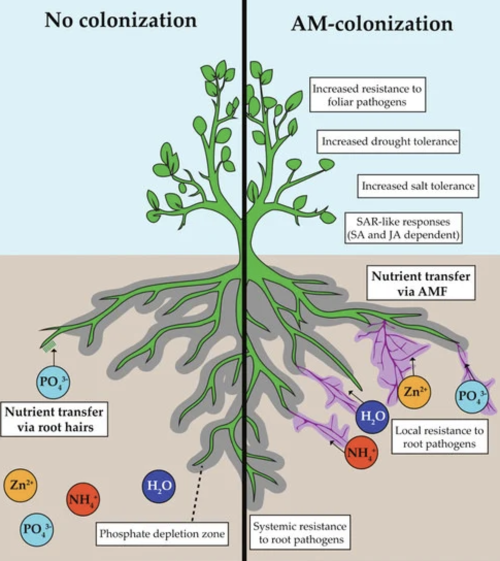
Host plants and Arbuscular Mycorrhizal Fungi are very different in their structures and abilities. Plants are larger with some parts above ground and other parts below. They have leaves, stems, chlorophyl and many other attributes that the AMF does not. Conversely, while it may seem like a disadvantage for the AMF to be smaller, their size and ability to create large colonial networks allows them to access parts of the soil that the host plant's root system is otherwise unable to. From these differences rises the core of the symbiotic relationship between AMF and their host, the exchange of carbon (C) and phosphorous (P). REF20 Plants absorb carbon dioxide and through the carbon fixation cycle they transform it into carbohydrates. AMF do not have this same capability since they live below ground and do not have the same exposure to carbon as plants. The first part of the symbiotic relationship is, through the root colonization by AMF, the host plant will transfer between 4% and 20% of the their photosynthetic carbon to the AMF. REF20 In addition to using the transferred carbon, the AMF will also act as a storage unit for the host plant, allowing it to have a greater carbohydrate reserve on hand. REF20 When the carbon is transferred, it is the forms of hexose and fatty acids. REF20
There are typically two methods for a terrestrial plant to acquire minerals and nutrients from the soil: root pathways and AMF. REF20 In order to complete the symbiotic relationship, Arbuscular Mycorrhizal Fungi transfer phosphorous from the soil to the plant. Phosphorus is most commonly found in the soil in the form of orthophosphates, H2PO4- and HPO4- Arbuscular Mycorrhizal Fungi's structures are better suited to seeking out phosphorous than a plants roots. The hyphal networks are often larger than a plants root system, allowing AMF to cover a larger area when looking for phosphorus. Additionally, the individual arms of the hyphae are smaller than that of a root. This allows them to travel through smaller pores in the soil. REF21 REF22 The increased phosphoric absorption by the host plant has been shown to contribute to increased growth. REF23 This underscores the importance of the core element of the symbiotic relationship. However, phosphorus is not the only mineral transferred to the host. AMF have also been shown to uptake and transfer zinc (Zn), iron (Fe), copper (Cu), nitrogen (N), potassium (K), calcium (Ca) and magnesium (Mg). REF23 It has been found that plants with the presence of AMF will frequently have higher levels of these elements. REF23
Cheating the Symbiosis and the Exchange
When the Arbuscular Mycorrhizal Fungi and the host plant are under certain conditions, the AMF has been shown to cheat the host plant by tricking it to supply carbon without sending any nutrients back. REF24 Not only does this provide an even greater benefit to the AMF than normal since they continue to gain from receiving carbon without encountering any of the costs of transferring nutrients back, it has been shown to be very costly to the host plant. In some cases it has been linked to a decline in plant growth. REF24 However, this relationship is very hard to prove and to investigate as AMF offer a large variety of benefits to the host plant and many can only be observed under certain conditions. REF25 This is still an emerging area of research with new discoveries constantly being made.
Benefits to the Host Plant Beyond Nutrient Exchange
While the core of the symbiotic relationship is nutrient transfer, particularly phosphorous, there are countless other benefits for the host that go beyond this including: increased drought resistance and increased soil structure and the prevention of mineral leeching during rainfall REF31.
Increased Drought Resistance
Water is crucial to a plant's survival. Different plants may have different levels of natural tolerance for water deprivation, a complete lack of water will eventually kill any plant, just like any other living thing. There has been a significant amount of research that has shown that the mutualistic relationship between the host and AMF can increase the host's drought resistance. REF21 There are several reasons that are thought to individual and/or collectively work to increase a plant's drought resistance. First, AMF increase the hydraulic conductivity of the host plant's roots. REF21 REF22 Hydraulic conductivity refers to how well a plant can move water through its roots, across gradients, to the xylem in the plant stem. Properties of AMF including the hyphal network are thought to increase the host plant's ability to effectively move water. Second, it is believed that AMF can increase the host plant's ability to regulate its somata. REF21 REF22 The stomata are typically the underside of a plant's leaves although in some plants they are on the stem. They regulate the gas exchange in plants however when they open, evaporation leads to water loss. Stomata have to open during the day so that photosynthesis can occur but this means that they are open when the plant is most susceptible to water loss from evaporation due to the sunlight. Giving the plant a greater ability to control the stomata would lead to reduced water loss from evaporation. Many droughts, not all, occur in hot, arid climates. This underscores the importance of reducing water loss from evaporation. The third suggestion to why Arbuscular Mycorrhizal Fungi provide increased drought resistance is that the hyphal network gives the plant's own root system a greater amount of contact with the soil. REF21 REF22 This is believed to allow plant's to extract greater amounts of water from the soil including from pores that would have otherwise been too small without AMF. REF21 REF22
Arbuscular Mycorrhizal Fungi in Farming
Conclusion
Overall text length (all text sections) should be at least 1,000 words (before counting references), with at least 2 images.
Include at least 5 references under References section.
References
extra stuff
vancouver citations recommended
Include some current research, with at least one image.
Sample citations: [2]
[3]
A citation code consists of a hyperlinked reference within "ref" begin and end codes.
For multiple use of the same inline citation or footnote, you can use the named references feature, choosing a name to identify the inline citation, and typing [5]
Second citation of Ref 1: [2]
- ↑ 1.0 1.1 1.2 1.3 Sanders IR, Croll D. Arbuscular Mycorrhiza: The challenge to understand the genetics of the fungal partner. Annual Review of Genetics. 2010;44(1):271–92
- ↑ 2.0 2.1 Hodgkin, J. and Partridge, F.A. "Caenorhabditis elegans meets microsporidia: the nematode killers from Paris." 2008. PLoS Biology 6:2634-2637.
- ↑ Bartlett et al.: Oncolytic viruses as therapeutic cancer vaccines. Molecular Cancer 2013 12:103.
- ↑ Lee G, Low RI, Amsterdam EA, Demaria AN, Huber PW, Mason DT. Hemodynamic effects of morphine and nalbuphine in acute myocardial infarction. Clinical Pharmacology & Therapeutics. 1981 May;29(5):576-81.
- ↑ 5.0 5.1 text of the citation
Edited by [Sebastian Jones], student of Joan Slonczewski for BIOL 116 Information in Living Systems, 2022, Kenyon College.
